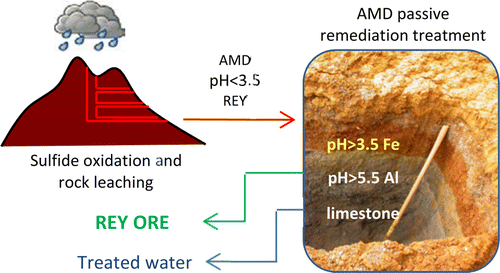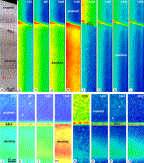Plants
Accumulation and speciation of nutrients and pollutants in plants
Plants are the basic source of energy in terrestrial ecosystems, thus the accumulation of nanoparticles can resonate across the entire food chain. Therefore, it is important to asses: (1) if plants accumulate the target nanoparticle, (2) where they accumulate it and (3) in what form they accumulate it. This information can help provide idea of their potential effects on human health. At ID21 a major focus on the fate of nanoparticles (Ce, Ti and Ag) in model plants has provided vital information to assess their potential nutritional impacts.
 |
B. Yan, M.-P. Isaure, S. Mounicou, H. Castillo-Michel, W. De Nolf, C. Nguyen and J.-Y. Cornu, "Cadmium distribution in mature durum wheat grains using dissection, laser ablation-ICP-MS and synchrotron techniques", Environ. Pollut. 113987 (2020). |
Understanding how essential and toxic elements are distributed in cereal grains is a key to improving the nutritional quality of cereal-based products. The main objective of this work was to characterize the distribution of Cd and of nutrients (notably Cu, Fe, Mn, P, S and Zn) in the durum wheat grain. Laser ablation inductively coupled mass spectrometry and synchrotron micro X-ray fluorescence were used for micro-scale mapping of Cd and nutrients. A dissection approach was used to quantitatively assess the distribution of Cd and nutrients among grain tissues. Micro X-ray absorption near-edge spectroscopy was used to identify the Cd chemical environment in the crease. Cadmium distribution was characterized by strong accumulation in the crease and by non-negligible dissemination in the endosperm. Inside the crease, Cd accumulated most in the pigment strand where it was mainly associated with sulfur ligands. High-resolution maps highlighted very specific accumulation areas of some nutrients in the germ, for instance Mo in the root cortex primordia and Cu in the scutellum. Cadmium loading into the grain appears to be highly restricted. In the grain, Cd co-localized with several nutrients, notably Mn and Zn, which challenges the idea of selectively removing Cd-enriched fractions by dedicated milling process.
 |
|
 |
L. Monico, L. Sorace, M. Cotte, W. de Nolf, K. Janssens, A. Romani and C. Miliani, "Disclosing the Binding Medium Effects and the Pigment Solubility in the (Photo) reduction Process of Chrome Yellows (PbCrO4/PbCr1–x S x O4)", ACS Omega, 4, 6607-6619 (2019). |
Iron is an essential cofactor for symbiotic nitrogen fixation, required by many of the enzymes involved, including signal transduction proteins, O2 homeostasis systems, and nitrogenase itself. Consequently, host plants have developed a transport network to deliver essential iron to nitrogen-fixing nodule cells. Ferroportin family members in model legume Medicago truncatula were identified and their expression was determined. Yeast complementation assays, immunolocalization, characterization of a tnt1 insertional mutant line, and synchrotron-based X-ray fluorescence assays were carried out in the nodule-specific M. truncatula ferroportin Medicago truncatula nodule-specific gene Ferroportin2 (MtFPN2) is an iron-efflux protein. MtFPN2 is located in intracellular membranes in the nodule vasculature and in inner nodule tissues, as well as in the symbiosome membranes in the interzone and early-fixation zone of the nodules. Loss-of-function of MtFPN2 alters iron distribution and speciation in nodules, reducing nitrogenase activity and biomass production. Using promoters with different tissular activity to drive MtFPN2 expression in MtFPN2 mutants, we determined that expression in the inner nodule tissues is sufficient to restore the phenotype, while confining MtFPN2 expression to the vasculature did not improve the mutant phenotype. These data indicate that MtFPN2 plays a primary role in iron delivery to nitrogen-fixing bacteroids in M. truncatula nodules.
 |
C. Ayora, F. Macías, E. Torres, A. Lozano, S. Carrero, J.-M. Nieto, R. Pérez-López, A. Fernández-Martínez and H. Castillo-Michel, "Recovery of Rare Earth Elements and Yttrium from Passive-Remediation Systems of Acid Mine Drainage", Environmental science & technology, 50, 8255-8262 (2016). |
Rare earth elements and yttrium (REY) are raw materials of increasing importance for modern technologies, and finding new sources has become a pressing need. Acid mine drainage (AMD) is commonly considered an environmental pollution issue. However, REY concentrations in AMD can be several orders of magnitude higher than in naturally occurring water bodies. With respect to shale standards, the REY distribution pattern in AMD is enriched in intermediate and valuable REY, such as Tb and Dy. The objective of the present work is to study the behavior of REY in AMD passive-remediation systems. Traditional AMD passive remediation systems are based on the reaction of AMD with calcite-based permeable substrates followed by decantation ponds. Experiments with two columns simulating AMD treatment demonstrate that schwertmannite does not accumulate REY, which, instead, are retained in the basaluminite residue. The same observation is made in two field-scale treatments from the Iberian Pyrite Belt (IPB, southwest Spain). On the basis of the amplitude of this process and on the extent of the IPB, our findings suggest that the proposed AMD remediation process can represent a modest but suitable REY source. In this sense, the IPB could function as a giant heap-leaching process of regional scale in which rain and oxygen act as natural driving forces with no energy investment. In addition to having environmental benefits of its treatment, AMD is expected to last for hundreds of years, and therefore, the total reserves are practically unlimited.
 |
Y. Dauphin, H. Castillo-Michel, B. Farre, A. Mataame, K. Rbii, A. Rihane, E. Stoetzel and C. Denys, "Identifying predation on rodent teeth through structure and composition: A case from Morocco", Micron, 75, 34-44 (2015). |
Predation by nocturnal birds of prey is one of the most frequent modes leading to the concentration of rodents in fossil assemblages. This mode of accumulation leaves characteristic surface alterations on bones and teeth. In order to evaluate and characterize the effects of these pre-diagenesis alterations on rodent fossil samples, we have carried out microstructural and chemical analyses on incisors collected from present day Moroccan wild animals and owl pellets. The microstructure of both dentine and enamel was well preserved, but chemical changes were evident in pellet samples and depended on the particular tissue and the nature of the predator. The comparison of compositional data obtained from electron microprobe chemical analyses and infrared spectrometry has allowed us to assign a possible predator to an incisor extracted from a pellet of an unknown origin. This method has further implications for the understanding of taphonomy and palaeoecology of archaeological and fossil sites.



